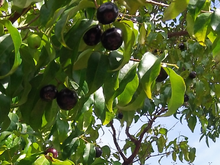Eugenia candolleana
| Eugenia candolleana | |
|---|---|

| |
| Frond and ripe fruit. | |
| Scientific classification | |
| Kingdom: | Plantae |
| Clade: | Tracheophytes |
| Clade: | Angiosperms |
| Clade: | Eudicots |
| Clade: | Rosids |
| Order: | Myrtales |
| Family: | Myrtaceae |
| Genus: | Eugenia |
| Species: | E. candolleana |
| Binomial name | |
| Eugenia candolleana DC. | |
Eugenia candolleana, or rainforest plum, is a tree native from Atlantic rainforest of Brazil, known locally by the Portuguese names cambuí roxo ('purple cambuí') or murtinha ('little myrtle').[1] It is quite rare in the wild, and has seen limited use in landscaping for its bright green foliage and purple-black fruits.[citation needed]
The species is named after the 19th-century Swiss botanist Augustin Pyramus de Candolle.[2] The common name cambuí means 'thin-branched tree' in Tupi-Guarani language, and is applied to over 100 different species.
Description
The adult tree is 3–6 m (9.8–19.7 ft) tall,[3] with rounded or conical canopy up to 2 m (6.6 ft) wide. New leaves are rusty-brown, turning yellow and then deep dark green. The reddish-brown bark peels off naturally showing a smooth reddish trunk. Leaves are simple, in opposite pairs, with smooth leathery texture, smooth edges, and the apex curved downwards.[citation needed]
Flowers are borne from November through January; they come in groups of 20 or more stalks, each bearing two flowers, sprouting from the base of leaf stalks.[1]
Fruits mature between February and March. The ripe fruit is a round or slightly elongated berry, up to 20 mm (0.79 in) wide and 25 mm (0.98 in) long. It has a thin purple-black skin and a wet, firm, whitish pulp about 3–5 mm (0.12–0.20 in) thick, surrounding a loose single (rarely double) seed. It is edible, moderately sweet, with an aroma similar to (but less intense than) that of the jabuticaba.[4]
Cultivation
The tree can be propagated from seeds, is easy to grow and bears fruit after two years. It thrives best in full sunlight and requires good irrigation during the flowering and fruiting seasons.[1]
Uses
The fruit are consumed fresh or made into jams. In the folk medicine of the region of Sergipe, the infusion of leaves has been used for the treatment of pain and fever.[5] The essential oil distilled from the leaves (green 0.14% by weight) contains isomers of guaiol and cadinol, δ-elemene and viridiflorene.[3]
Images
 | ||
 |
 |
 |
See also
- Myrciaria floribunda (cambuí vermelho)
References
- ^ a b c EUGENIA CANDOLLEANA E MYRCIARIA FLORIBUNDA at the Frutas Raras site (in Portuguese). Accessed on 2012-02-27.
- ^ "Plant Names C - F". The Eponym Dictionary of Southern African Plants. Retrieved 4 September 2012.
- ^ a b Marcos J. Nakamura, Sérgio S. Monteiro, Carlos H.B. Bizarri, Antonio C. Siani, Mônica F.S. Ramos (2010) Essential oils of four Myrtaceae species from the Brazilian southeast. Biochemical Systematics and Ecology, volume 38, issue 6, pages 1170–1175 doi:10.1016/j.bse.2010.11.003
- ^ Trade Winds Fruit, Rainforest Plum, Eugenia candolleana a.k.a. Cambuí. Accessed on 2012-02-27.
- ^ Adriana G. Guimarães, Mônica S. Melo, Rangel R. Bonfim, Luiz O. Passos, Samísia M.F. Machado, Adauto de S. Ribeiro, Marcos Sobral, Sara M. Thomazzi, Lucindo J. Quintans-Júnior (2009) Antinociceptive and anti-inflammatory effects of the essential oil of Eugenia candolleana DC., Myrtaceae, on mice. Revista Brasileira de Farmacognosia volume 19 issue 4 doi:10.1590/S0102-695X2009000600016
